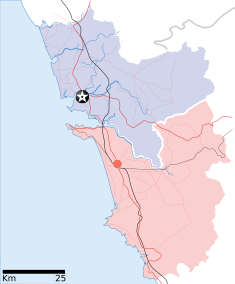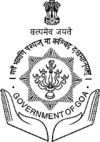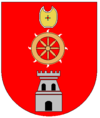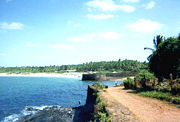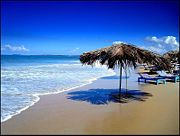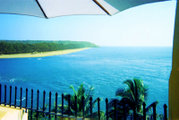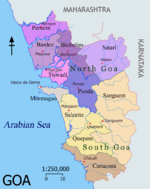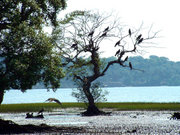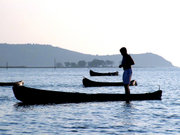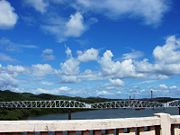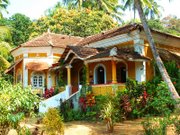Goa
2008/9 Schools Wikipedia Selection. Related subjects: Geography of Asia
| ?गोंय गोवा Goa India |
|
|
|
|
| Coordinates: | |
| Time zone | IST ( UTC+5:30) |
| Area | 3,702 km² (1,429 sq mi) |
| Capital | Panaji |
| Largest city | Vasco da Gama |
| District(s) | 2 |
| Population • Density |
1,400,000 ( 25th) • 363 /km² (940 /sq mi) |
| Language(s) | Konkani↑ |
| Governor | SC Jamir |
| Chief Minister | Digambar Kamat |
| Established | 1987- 05-30 |
| Legislature (seats) | Unicameral (40) |
| ISO abbreviation | IN-GA |
| Website: goagovt.nic.in | |
| "↑" Konkani is the sole official language but Marathi is also allowed to be used for any or all official purposes. | |
| Seal of Goa | |
Coordinates: Goa pronunciation ( Konkani: गोंय /ɡɔ̃j/) is India's smallest state in terms of area and the fourth smallest in terms of population. Located on the west coast of India in the region known as the Konkan, it is bounded by the state of Maharashtra to the north, and by Karnataka to the east and south, while the Arabian Sea forms its western coast.
Panaji (also referred to as Panjim) is the state's capital. Vasco da Gama (sometimes shortened to Vasco) is the largest city. The historic city of Margao still exhibits the influence of Portuguese culture. Portuguese first landed in Goa as merchants, in the early 16th century, and conquered it soon after. The Portuguese colony existed for about 450 years (one of the longest held colonial possessions in the world), until it was taken over by India in 1961.
Renowned for its beaches, temples and world heritage architecture, Goa is visited by hundreds of thousands of international and domestic tourists each year. It also has rich flora and fauna, owing to its location on the Western Ghats range, which is classified as a biodiversity hotspot. One of the most developed states in India, Goa enjoys a high standard of living.
Origin of name
The name Goa came to European languages from the Portuguese colonisers, but its precise origin is unclear. The name Goa is said to have been derived from the Konkani word 'Goy', which means a patch of tall grass. The Indian epic Mahabharata refers to the area now known as Goa, as 'Goparashtra' or 'Govarashtra"' which means a nation of cowherds. 'Gopakapuri' or 'Gopakapattanam' were used in some ancient Sanskrit texts, and these names were also mentioned in other sacred Hindu texts such as the Harivansa and the Skanda Purana. In the latter, Goa is also known as "Gomanchala". Gove, Govapuri, Gopakpattan, Gomantak and Gomant are some other names that the region is referred to in certain inscriptions and texts such as the Puranas..Goan Hindus refer to Goa as Gomantak.
History
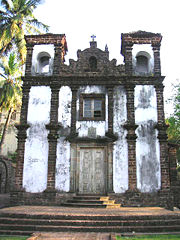
Goa's known history stretches back to the 3rd century BC, when it formed part of the Mauryan Empire. It was later ruled by the Satavahanas of Kolhapur, around 2000 years ago it was passed on to the Chalukya Dynasty, who controlled it between 580 to 750. Over the next few centuries Goa was successively ruled by the Silharas, the Kadambas and the Chalukyas of Kalyani, rulers of Deccan India. The Kadambas, a local Hindu dynasty based at Chandrapura, (present day Chandor - Salcete), laid an indelible mark on the course of Goa's pre-colonial history and culture.
In 1312, Goa came under the governance of the Delhi Sultanate. However, the kingdom's grip on the region was weak, and by 1370 they were forced to surrender it to Harihara I of the Vijayanagara empire. The Vijayanagara monarchs held on to the territory until 1469, when it was appropriated by the Bahmani sultans of Gulbarga. After that dynasty crumbled, the area fell to the hands of the Adil Shahis of Bijapur who made Velha Goa their auxiliary capital.
Portuguese influence
In 1498, Vasco da Gama became the first European to set foot in India through a sea route, landing in Calicut (Kozhikode) in Kerala, followed by an arrival in what is now known as Old Goa. Goa, then a term referring to the City of Goa on the southern bank of the River Mandovi, was the largest trading centre on India's western coast. The Portuguese arrived with the intention of setting up a colony and seizing control of the spice trade from other European powers after traditional land routes to India had been closed by the Ottoman Turks. Later, in 1510, Portuguese admiral Afonso de Albuquerque defeated the ruling Bijapur kings with the help of a local ally, Timayya, leading to the establishment of a permanent settlement in Velha Goa (or Old Goa). The Portuguese intended it to be a colony and a naval base, distinct from the fortified enclaves established elsewhere along India's coasts.
Opposition
In 1668, Chatrapti Shivaji captured five towns in North Goa and ordered renovation of "Saptkotishwar" temple at the present site during one of his campaigns to oust the Portuguese. Even after repetitive attempts, he was not able to win Goa from the Portuguese.[20]In 1685, Chatrapti Sambhaji captured capital Panaji and penetrated his Maratha army peacefully in entire Central and North Goa but could not retain Goa and again moved to Deccan plateau to handle the situation arisen due to sudden attack of Mogul.
With the imposition of the Inquisition (1560–1812), many of the local residents were forcibly converted to Christianity by missionaries, threatened by punishment or confiscation of land, titles or property. Many converts however retained parts of their Hindu heritage. To escape the Inquisition and harassment, thousands fled the state, settling down in the neighbouring towns of Mangalore and Karwar in Karnataka, and Savantwadi in Maharashtra.
Other European powers
With the arrival of the other European powers in India in the 16th century, most Portuguese possessions were surrounded by the British and the Dutch. Goa soon became Portugal's most important possession in India, and was granted the same civic privileges as Lisbon. In 1843 the capital was moved to Panjim from Velha Goa. By mid-18th century the area under occupation had expanded to most of Goa's present day state limits.
Indian Invasion
After India gained independence from the British in 1947, Portugal refused to accede to India's demand to relinquish their control of its enclave. Resolution 1541 by the United Nations General Assembly in 1960 noted that Goa was non-self-governing and favoured self determination. Finally, on December 12, 1961, the Indian army with 40,000 troops moved in as part of Operation Vijay. Fighting lasted for twenty-six hours before the Portuguese garrison surrendered. Goa, along with Daman and Diu (enclaves lying to the north of Maharashtra), was made into a centrally administered Union Territory of India. India's Invasion of Goa is commemorated on December 19 (Liberation Day). The UN Security Council considered a resolution condemning the invasion which was vetoed by the Soviet Union. Most nations later recognised India's action, and Portugal recognised it after the Carnation Revolution in 1974. On May 30, 1987, the Union Territory was split, and Goa was elevated as India's twenty-fifth state, with Daman and Diu remaining Union Territories.
-
- .
Geography and climate
Goa encompasses an area of 3,702 km² (1,430 sq mile). It lies between the latitudes 14°53'54" N and 15°40'00" N and longitudes 73°40'33" E and 74°20'13" E. Most of Goa is a part of the coastal country known as the Konkan, which is an escarpment rising up to the Western Ghats range of mountains, which separate it from the Deccan Plateau. The highest point is the Sonsogor, with an altitude of 1,167 meters (3,827 feet). Goa has a coastline of 101 km (63 miles).
Goa's main rivers are the Mandovi, the Zuari, the Terekhol, Chapora River and the Betul. The Mormugao harbour on the mouth of the river Zuari is one of the best natural harbors in South Asia. The Zuari and the Mandovi are the lifelines of Goa, with their tributaries draining 69% of its geographic area. Goa has more than forty estuarine, eight marine and about ninety riverine islands. The total navigable length of Goa's rivers is 253 km (157 miles). Goa has more than three hundred ancient tanks built during the rule of the Kadamba dynasty and over a hundred medicinal springs.
Most of Goa's soil cover is made up of laterites which are rich in ferric aluminium oxides and reddish in colour. Further inland and along the river banks, the soil is mostly alluvial and loamy. The soil is rich in minerals and humus, thus conducive to plantation. Some of the oldest rocks in the Indian subcontinent are found in Goa between Molem and Anmod on Goa's border with Karnataka. The rocks are classified as Trondjemeitic Gneiss estimated to be 3,600 million years old, dated by the Rubidium isotope dating method. A specimen of the rock is exhibited in the Goa University.
Goa, being in the tropical zone and near the Arabian Sea, has a warm and humid climate for most of the year. The month of May is the hottest, seeing day temperatures of over 35 ° C (95 ° F) coupled with high humidity. The monsoon rains arrive by early June and provide a much needed respite from the heat. Most of Goa's annual rainfall is received through the monsoons which last till late September.
Goa has a short cool season between mid-December and February. These months are marked by cool nights of around 20 °C (68 °F) and warm days of around 29 °C (84 °F) with moderate amounts of humidity. Further inland, due to altitudinal gradation, the nights are a few degrees cooler. During March 2008 Goa was lashed with heavy rain and strong winds. This was the first time in 29 years that Goa had seen rain during March.
Subdivisions
The state is divided into two districts: North Goa and South Goa. Panaji is the headquarters of the north Goa district and Margao of the south district. Each district is governed by a district collector, an administrator appointed by the Indian government.
The districts are further divided into eleven talukas – Talukas of North Goa are Bardez, Bicholim, Pernem, Ponda, Satari and Tiswadi, the talukas of South Goa are Canacona, Mormugao, Quepem, Salcete and Sanguem. Headquarters of the respective talukas are Mapusa, Bicholim, Pernem, Ponda, Valpoi, Panjim, Chaudi, Vasco, Quepem, Margao and Sanguem.
In the Parliament of India, Goa has two seats in the Lok Sabha, one representing each district, and one seat in the Rajya Sabha.
Flora and fauna
Forest cover in Goa stands at 1,424 km², most of which is owned by the government. Government owned forest is estimated at 1224.38 km² whilst private is given as 200 km². Most of the forests in the state are located in the interior eastern regions of the state. The Western Ghats, which form most of eastern Goa, have been internationally recognised as one of the biodiversity hotspots of the world. In the February 1999 issue of National Geographic Magazine, Goa was compared with the Amazon and Congo basins for its rich tropical biodiversity.
Goa's state animal is the Gaur, the state bird is the Ruby Throated Yellow Bulbul, which is a variation of Black-crested Bulbul, and the state tree is the Asan.
The important forests products are bamboo canes, Maratha barks, chillar barks and the bhirand. Coconut trees are ubiquitous and are present in almost all areas of Goa barring the elevated regions. A large number of deciduous vegetation consisting of teak, sal, cashew and mango trees are present. Fruits include jackfruits, mangos, pineapples and blackberries.
Foxes, wild boars and migratory birds are found in the jungles of Goa. The avifauna includes kingfishers, mynas and parrots. Numerous types of fish are also caught off the coast of Goa and in its rivers. Crabs, lobsters, shrimps, jellyfish, oysters and catfish form some of the piscine catch. Goa also has a high snake population, which keeps the rodent population in control. Goa has many famous National Parks, including the renowned Salim Ali bird sanctuary. Other wildlife sanctuaries include the Bondla Wildlife Sanctuary, Molem Wildlife Sanctuary, Cotigao Wildlife Sanctuary, Madei Wildlife Sanctuary, Netravali Wildlife Sanctuary Mahaveer Wildlife Sanctuaryand the Salim Ali Bird Sanctuary located on the island of Chorao.
Goa has more than 33% of its geographic area under government forests (1224.38 km²) of which about 62% has been brought under Protected Areas (PA) of Wildlife Sanctuaries and National Park. Since there is a substantial area under private forests and a large tract under cashew, mango, coconut, etc. plantations, the total forest and tree cover constitutes 56.6% of the geographic area.
Economy
| Gross State Domestic Product at Current Prices (in millions of Indian Rupees) figures in crores of Indian Rupees |
|
| Year | Gross State Domestic Product |
|---|---|
| 1980 | 3,980 |
| 1985 | 6,550 |
| 1990 | 12,570 |
| 1995 | 33,190 |
| 2000 | 76,980 |
Goa's gross state domestic product for 2004 is estimated at $3 billion in current prices. Goa is India's richest state with a GDP per capita two and a half times that of the country as a whole, and one of its fastest growth rates: 8.23% (yearly average 1990–2000).
Tourism is Goa's primary industry: it handles 12% of all foreign tourist arrivals in India. Goa has two main tourist seasons: winter and summer. In the winter time, tourists from abroad (mainly Europe) come to Goa to enjoy the splendid climate. In the summertime (which, in Goa, is the rainy season), tourists from across India come to spend the holidays. Tourism is generally focused on the coastal areas of Goa, with decreased tourist activity inland. In 2004 there were more than 2 million tourists reported to have visited Goa, 400,000 of which were from abroad.
The land away from the coast is rich in minerals and ores and mining forms the second largest industry. Mining in Goa focuses on ores of iron, Bauxite, manganese, clays, limestone and silica. The Marmagao Port handled 31.69 million tonnes of cargo last year, and accounts for over 39% of India's Iron Ore exports. The leaders in the Goan Iron Ore industry include Sesa Goa (now owned by Vedanta) and Dempo
Agriculture, while of shrinking importance to the economy over the past four decades, offers part-time employment to a sizable portion of the populace. Rice is the main agricultural crop, followed by areca, cashew and coconut. The fishing industry provides employment for about forty thousand people, though recent official figures indicate a decline of the importance of this sector and also a fall in catch, perhaps coupled with the fact that traditional fishing has given way to large-scale mechanised trawling. Medium scale industries include the manufacturing of pesticides, fertilisers, tyres, tubes, footwear, chemicals, pharmaceuticals, wheat products, steel rolling, fruits and fish canning, cashew nuts, textiles, brewery products. Goa is also notable for its low liquor prices due to its very low excise duty on alcohol. Another source of cash inflow into the state comes from many of its citizens who work abroad and remit money to their families. Zuari Industries (2005 gross income Rs.36,302 million) and Sesa Goa (2005 gross income Rs.17,265 million) are two S&P CNX 500 conglomerates which have corporate offices in Goa. The Goa government has recently decided to not allow any more special economic zones(SEZs) in Goa. This is in stark contrast to policy followed by other states of India. SEZs are known to bring tax revenues for the government and employment option for local citizens since industries flock there for lower tax rates as compared to other areas. Currently there are 16 planned SEZs in Goa. This decision was taken by state government after strong opposition to SEZs by political parties and Goa catholic church.
Transport
Goa's sole airport, the Dabolim Airport, is both a military and civilian airport catering to domestic and international airlines that stop en route to other Indian destinations. In addition to regular flights, the airport handles a large number of chartered flights. Goa receives International flights from Dubai, Sharjah and Kuwait in the Middle East and from the United Kingdom, Germany and Russia during the charter flight tourist season. Dabolim airport is serviced by the following carriers - Air India, Indian Airlines, Air Deccan, Kingfisher airlines, Go air, Spice jet, Jet Airways besides Charter flights from Thomas Cook (condor) etc.
Goa's public transport largely consists of privately operated buses linking the major towns to rural areas. Government-run buses, maintained the Kadamba Transport Corporation, links both major routes (like the Panjim–Margao route) and some remote parts of the state. In large towns such as Panjim and Margao, intra-city buses ply. However, public transport in Goa is less developed, and residents depend heavily on their own transport, usually motorised two-wheelers. Goa has two National Highways passing through it. NH-17 runs along India's west coast and links Goa to Bombay in the north and Mangalore to the south. NH-4A running across the state connects the capital Panjim to Belgaum in east, linking Goa to cities in the Deccan. The NH-17A connects NH-17 to Mormugao Harbour from Cortalim, and the new NH-17B, once complete will be a four lane highway connecting Mormugao Harbour to NH-17 at another location, Verna, via Dabolim airport. Goa has a total of 224 km (139 mi) of National highway, 232 km (144 mi) of state highway and 815 km of district highway.
Hired forms of transport include unmetered taxis, and, in urban areas, auto rickshaws. A unique form of transport in Goa is the Motorcycle taxi, operated by drivers who are locally called "pilots". These vehicles transport a single pillion rider, at fares that are usually negotiated prior or after the journey (it is always better to ask locals on the correct fare before you try any negotiations yourself). In some places in Goa, there are river crossings which are serviced by the ferry boats, operated by the river navigation departments. Goa has two rail lines — one run by the South Western Railway and the other by the Konkan Railway. The line run by the South Western Railway was built during the colonial era linking the port town of Vasco da Gama with Hubli in Karnataka via Margao. The Konkan Railway line, which was built during the 1990s, runs parallel to the coast connecting Mumbai to the Malabar Coast.
The Mormugao harbour near the city of Vasco handles mineral ore, petroleum, coal and international containers. Much of the shipments consist of minerals and ores from Goa's hinterland. Panjim, which is situated on the banks of the Mandovi, also has a minor port, which used to handle passenger steamers between Goa and Mumbai till the late 1980s.
Demographics
A native of Goa is called a Goan in English, 'Goenkar' in Konkani, 'Goês' (male) or 'Goesa' (female) in Portuguese, and a 'Govekar' in Marathi. Goa has a population of 1.344 million residents, making it India's fourth smallest (after Sikkim, Mizoram and Arunachal Pradesh). The population has a growth rate of 14.9% per decade . There are 363 people for each square kilometre of the land. 49.77% of the population lives in urban areas. The sex ratio is 960 females to 1000 males. Hinduism (65.8%), Christianity (26.7%) and Islam (6.8%) are the three main religions in Goa. Roman Catholicism reached Goa during the period of European colonisation, which began in 1498 when the Portuguese explorer Vasco da Gama arrived on the Malabar coast. With the establishment of Goa Inquisition in 1560, a large sections of the population became Roman Catholic. Goa's major cities include Vasco, Margao, Marmagao (also known as Murgaon or Mormugão), Panjim and Mapusa. The region connecting the last four cities is considered a de facto conurbation, or a more or less continuous urban area.
The official language of Goa is Konkani. Following the end of Portuguese rule, the most widely used languages are Konkani and Marathi. Konkani is the primary spoken language; Marathi and English for official, literary or educational purposes; and other languages including Hindi and Portuguese. Language is a controversial issue between two contending camps: pro-Konkani and pro-Marathi. Most of the Goans united and fought for Konkani as their mother tongue. After 1987, a complex formula grants 'official language' status to Konkani, while Marathi is also allowed to be used "for any or all official purposes." Portuguese, the earlier language of the colonial elite, has been hit by shrinking numbers, though a small number still prefer it as the medium for discourse at home, and a few Portuguese books have even been published in recent years. English, viewed as a language of opportunity and social mobility, is widely understood by many of the state residents.
- Birth Rate: 15.70 per 1000 people in 2007.
- Death Rate: 8.29 per 1000 people in 2007.
Culture
The most popular celebrations in Goa are Ganesh Chaturthi (Chavoth-Konkani), Diwali, Christmas, Easter Sunday, Samvatsar Padvo, Shigmo and the Carnival, New Year's Day. However, since the 1960s, the celebrations of the Shigmo and carnival have shifted to the urban centres, and in recent times these festivals are seen more as a means of attracting tourists.
Goan Hindus are very fond of Natak, Bhajan and Kirtan. Many famous Indian Classical singers hail from Goa, such as Lata Mangeshkar, Asha Bhosle, Kishori Amonkar, Kesarbai Kerkar, Jitendra Abhisheki, Prabhakar Karekar.
Some traditional Goan dance forms are dekhnni, fugdi, and corridinho.
Rice with fish curry (Xit kodi in Konkani) is the staple diet in Goa. Goa is renowned for its rich variety of fish dishes cooked with elaborate recipes. Coconut and coconut oil is widely used in Goan cooking along with chili peppers, spices and vinegar giving the food a unique flavour. Pork dishes such as Vindaloo, Xacuti and Sorpotel are cooked for major occasions among the Catholics. An exotic Goan vegetable stew, known as Khatkhate, is a very popular dish during the celebrations of festivals, Hindu and Christian alike. Khatkhate contains at least five vegetables, fresh coconut, and special Goan spices that add to the aroma. A rich egg-based multi-layered sweet dish known as bebinca is a favourite at Christmas. The most popular alcoholic beverage in Goa is feni; Cashew feni is made from the fermentation of the fruit of the cashew tree, while coconut feni is made from the sap of toddy palms.
Goa has two World Heritage Sites: the Bom Jesus Basilica and a few designated convents. The Basilica holds the mortal remains of St. Francis Xavier, regarded by many Catholics as the patron saint of Goa (the patron of the Archdiocese of Goa is actually the Blessed Joseph Vaz. Once every twelve years, the body is taken down for veneration and for public viewing. The last such event was conducted in 2004. The Velhas Conquistas regions are also known for its Goa-Portuguese style architecture.
In many parts of Goa, mansions constructed in the Indo-Portuguese style architecture still stand, though in some villages, most of them are in a dilapidated condition. Fontainhas in Panjim, has been declared a cultural quarter, and are used as a living museum showcasing the life, architecture and culture of Goa. Some influences from the Portuguese era are visible in some of Goa's temples, notably the Mangueshi Temple, although after 1961, many of these were demolished and reconstructed in the indigenous Indian style.
Architecture
The height of Goa's glory was closely and mutually linked with the heyday of Portugal, but Goan grandeur pre-dated the Portuguese. Chieftains, kings and a host of Indian dynasties had made this little jewel glitter with royal pomp. The Batpuras, the Bhujas and, after the fall of Ashoka and the Mauryans, the Satyavahanas, ruled over Goa. The inscription of around A.D.1000 (when Shashtadeva of the Goa Kadamba dynasty sat on the throne), describes the early splendor of the capital: 'Gardens on every side.White plastered houses, alleys, horse stables, flower gardens, agreeably connected bazaars, harlots' quarters, and tanks.' In his son's reign, Goa is reputed to have commanded a powerful fleet and traded with four- teen foreign lands.In essence, it was a coveted land with the most sought-after port in India. And as the word spread, this advantage was to become a liability. The friendly harbours that had sent out sparkling blue ripples to the world were to backflow and become the road of conquest and colonization.
On July 4, 1497 when Vasco da Gama set sail from the River Tagus in Lisbon commanding the flagship St. Gabriel, no one could have imagined the implications of his voyage. At that time the potentates of the East were wealthier than the financially em- barrassed Western kings.Vasco da Gama never actually visited Goa, though now there is a coastal town by his name to commemorate his link with Portugal. It was Afonso de Albuquerque who is credited with sowing the seeds of the Portuguese empire in India, first by destroying, then creating. the Arabian Sea into the fresh mouth of the Mandovi. Little did anyone know that Goa would change face. Now a stranger on the throne was to remould the past, reshape the present and go so far as to influence the future psyche of an entire people.
The Portuguese brought to Goa the magnificence of the West and the might of a nation at the height of its imperial power. Their vision was lofty and ambition sky high, but it blazed a short trail like a meteor. An art historian remarked, 'Portugal was a very small nation of a people then heroic. However, at its peak, Goa was one of the wonders of the world, larger than Lisbon and even the London of its time! Some 300,000 people had made it their home. Goa re- sembled the 'meeting upon the burse in Antwerpe' wrote Linschoten, the Dutchman, and it was then that epithets like 'Rome of Asia' and 'Pearl of the Orient' were coined. 'Goa Dourada' or 'Golden Goa' sands was not an advertising slogan to beckon tourists, but more precisely the gilt-coated reredos and altars in the churches that dis- played layers of the real gold Portugal had discovered in Africa.
Contemporary descriptions do not undertake this glitter. 'Quem viu Goa excusa de ver Lisboa', the word went round, 'Who has seen Goa needn't see Lisbon.' In 1606 Goa got Santa Monica, the first nunnery in the East. The imposing Basilica of Bom Jesus impressed Christians and non-Christians alike. Fantastic Italian architecture-typically renaissance modelled on architectural details from the churches circled the city's skyline. There were compulsory orders to paint the mansions annually, af- ter the monsoon had passed. The regulations insisted that al- though white may be used for picking out architectural details like quoins and cornices, and window edges and balustrades to contrast with the wall surfaces of yellow-ochre, Indian red or pale green, no buildings but churches might be white all over. In 1839, Caption Marryat in his novel The Phantom Ship de described Goa: 'The squares behind the palace and the wide streets were filled with living beings: elephants with gorgeous trappings; led or mounted horses with superb housings; palanquins carried by natives in splendid liveries; running footmen; syces; every variety of nation, from the proud Portuguese to the half-covered native; Musselmen, Arabs, Hindoos, Armenians; Officers and soldiers in their uniforms, all crowded and thronged together: all was bustle and motion. Such was the wealth, the splendor and luxury of the proud city of Goa- the Empress of the East.'
Sports
Football is perhaps the most popular sport in Goa and is embedded in Goan culture. Its origins in the state are traced back to 1883 when the visiting British priest Fr. William Robert Lyons established the sport as part of a "Christian education". On December 22, 1959 the Associação de Futebol de Goa was formed, which continues to administer the game in the state under the new name, Goa Football Association. Goa, along with West Bengal,and Kerala. is the locus of football in the country and is home to many football club in India's National Football League, including three of the ten Premier Division teams. The state's football powerhouses include Salgaocar, Dempo, Churchill Brothers, Vasco Sports Club and Sporting Clube de Goa. The state's main football stadium, Fatroda (or Nehru stadium), is located at Margao and also hosts cricket matches.
In recent decades, a growing influence of cricket is visible, in large part fuelled by the massive coverage this sport gets on national television, thus making an impact even in a part of South Asia which hardly had any contact with the British Empire. Goa now has its own cricket team. Field Hockey is the third most popular sport.
Government and Politics
Panaji, known as Panjim in English and earlier called Pangim in Portuguese times, and known in the local language as Ponnje is the administrative capital of Goa lying on the left bank of the Mandovi near Panaji. Goa's legislative capital is Porvorim – the seat of the Goa assembly, which lies across the Mandovi River. The state's judicial capital, however, is Mumbai (formerly known as Bombay, which is the capital of Goa's neighbouring Maharashtra state), as the state comes under the Bombay High Court. A bench of the High Court is present in Panaji. Goa contributes two seats to the Lok Sabha and one to the Rajya Sabha, in India's bicameral parliament. Unlike other states, which follow the British Indian model of civil laws framed for individual religions, the Portuguese Uniform Civil Code, based on the Napoleonic code, has been retained by the Goa government.
Goa has a unicameral legislature consisting of a forty member Legislative Assembly, headed by a Chief Minister who wields the executive power. The present Chief Minister of Goa is Mr. Digamber Kamat and the Leader of Opposition is Mr. Manohar Parrikar. The ruling government consists of the party or coalition garnering the most seats in the state elections and enjoying the support of a simple majority of the House. The governor is appointed by the President of India. The governor's role is largely ceremonial, but plays a crucial role when it comes to deciding who should form the next government or in suspending the legislature as has happened in the recent past. After having stable governance for nearly thirty years up to 1990, Goa is now notorious for its political instability having seen fourteen governments in the span of the fifteen years between 1990 and 2005. In March 2005 the assembly was dissolved by the governor and President's Rule was declared, which suspended the legislature. A by-election in June 2005 saw the Congress coming back to power after winning three of the five seats that went to polls. The Congress party and the BJP are the two largest parties in the state. In the assembly pole of 2007, Congress-led coalition won and started ruling the state. Other parties include the United Goans Democratic Party, the Nationalist Congress Party and the Maharashtrawadi Gomantak Party.
Education
According to the 2001 census, Goa has a literacy rate of 82% with 89% of males and 76% of females being literate. Each taluka is made up of villages, each having a school run by the government. Due to the low levels of corruption and the quality of the government schools, private schools are less in demand, compared to the rest of the country. All schools come under the state SSC whose syllabus is prescribed by the state Education department. There are also a few schools run by the all-India ICSE board. Most students in Goa complete their high school using English as the medium of instruction. Primary schools, on the other hand are largely run in Konkani (in private, but government-aided schools). As is the case in most of India, enrollment for vernacular media has seen a fall in numbers in favour of English medium education.
After ten years of schooling, students join a Junior College which offers courses in popular streams such as Science, Arts, Law and Commerce. Additionally, many join three year diploma courses. Two years of college is followed by a professional degree. The Goa University is the sole university in the state located in Taleigao and all Goan colleges are affiliated to it. There are four engineering colleges and one medical college in the state. The Goa Engineering College and Goa Medical College are run by the state whereas the other three engineering colleges are run by private organisations.
In 2004, BITS Pilani university started its first Indian satellite, BITS Pilani Goa Campus near Dabolim. Unlike other Goan institutes, BITS Goa admits students through a nation wide aptitude test that it shares with its parent institute. Due to this BITS Pilani Goa Campus is the only college in the state to have a regionally mixed student body.
The other private engineering colleges are, Shree Rayeshwar Institute of Engineering and Information Technology, Shiroda, and Padre Conceicao College of Engineering, Verna. There are also colleges offering pharmacy, architecture and dentistry along with numerous private colleges offering law, arts, commerce and science. There is also two National Oceanographic Science related centres, NCAOR aand NIO in Vasco and Punjim.
Many residents, however, choose to take up courses in other states as the demand for a course in Goa is more than that available. Goa is also well-known in India for courses in marine engineering, fisheries, hotel management and cuisine. The State also hosts a business school - the Goa Institute of Management which is autonomous and was founded in 1993 by Romuald D'Souza. Portuguese is taught as a part of the school curriculum, often as a third language in some schools. The Goa University also offers Bachelors and Masters degrees in Portuguese.
